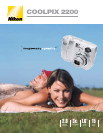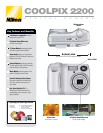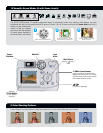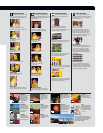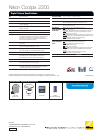
Night Landscape:
Use this mode to take in the
true splendor of a nighttime
scene using only ambient
light.
Close Up:
Used to capture vivid colors in
close-up shots of flowers,
insects and other small objects
Fireworks:
With short shutter release
time lag, slow shutter speed,
focus set at infinity, and
other specific settings, you
can capture fireworks in
all their original beauty.
Copy:
This mode is convenient when
shooting characters printed on
white material such as paper
or white board. This is a great
tool for application in business
or at school.
Back Light:
The Speedlight fires to
brighten subjects that are
backlit and would come out
dark if no flash was used.
Museum:
Disables flash for indoor
shooting in venues that do
not allow flash.
Dawn/Dusk:
Catches the natural-light
beauty of dim or hazy
situations, such as just
before sunrise or after
sunset.
Party/Indoor:
In dim light, a slower shutter
speed is automatically
selected to bring out the
background. In extremely
low-light situations, the
Slow Sync flash fires
automatically.
Beach/Snow:
When shooting a scene
with snow or water in the
background, the image is
free of grayish tones that
are caused by typical
underexposure.
Sunset:
Exposure is automatically
controlled, enabling you to
preserve the exquisite,
natural beauty of
a sunset.
NIGHT PORTRAIT ASSIST MODE:
Helps you frame portraits taken at night.
Using Slow Sync with Red-Eye Reduction in a scene
with an illuminated background, your subject is
naturally exposed.
Night Portrait:
(No guides are displayed in monitor.)
Use to focus on subject in center of frame.
Night Portrait left:
Use to focus on subject in
left half of frame.
Night Portrait right:
Use to focus on subject in
right half of frame.
Night Portrait close-up:
Use to focus on subject’s face in
top half of frame.
Night Portrait couple:
Use to focus on two subjects
positioned side-by-side.
Night Portrait figure:
Use to compose a vertical portrait. Camera
focuses on subject’s face in top half of frame.
PORTRAIT ASSIST MODE:
Helps you frame portraits. Your subject
comes out sharply focused with natural skin
tones against a soft, pleasant background.
Portrait:
(No guides are displayed in monitor.)
Camera focuses on subject in center of frame.
Portrait left:
Camera focuses on subject in
left half of frame.
Portrait right:
Camera focuses on subject in
right half of frame.
Portrait close-up:
Camera focuses on subject’s face in
top half of frame.
Portrait couple:
Camera focuses on two subjects
positioned side-by-side.
Portrait figure:
Use to compose a vertical portrait. Camera
focuses on subject’s face in top half of frame.
LANDSCAPE ASSIST MODE:
Helps you frame vivid landscape shots
that enhance outlines, colors, and contrast.
Landscape:
(No guides are displayed in monitor.)
Use to focus on distant objects through
foreground objects such as windows or a screen
of branches. Focus is fixed at infinity.
Scenic View:
Use to compose landscapes with sky in top third
of frame, distant objects in middle third, and
closer objects in bottom third.
Architecture:
Use to photograph buildings. A grid is displayed
in the monitor to help keep verticals and
horizontals aligned with the frame.
Group right:
Use to compose portraits with portrait subjects to
right and landmark or other object in background
at left of frame. Both stay in focus.
Group left:
Use to compose portraits with portrait subjects to
left and landmark or other object in background
at right of frame. Both stay in focus.
SPORTS ASSIST
MODE:
Is used for dynamic action shots that
capture moving objects. The assist menu lets you
freeze the action in a single shot or record motion
in a series of pictures.
Sports:
While shutter-release button is held down,
pictures are recorded at rate of about 3 frames
every 2 seconds. Focus, exposure and white
balance are determined by first shot in each
series. Camera focuses continuously, even when
shutter-release button is not pressed.
Sports spectator:
Shutter-release button can be pressed in one
motion without pausing halfway to check focus.
Use at ranges of 3m (9’10”) or more when
subject is moving unpredictably, leaving you no
time to compose pictures. Camera focuses
continuously, even when shutter-release button
is not pressed.
Sports composite:
Each time shutter-release button is pressed,
camera takes 16 shots in about two seconds
and arranges them in four rows to form a single
picture. Focus, exposure and white balance are
determined by first shot in each series.
Panorama Assist
Allows you to take several side-by-side images, all at
the same exposure and white balance setting, then
combine them later using the “Panorama Maker™”
photo editing software (supplied) to create
spectacular wide-vista photos.



